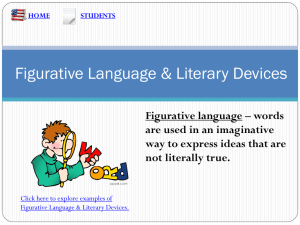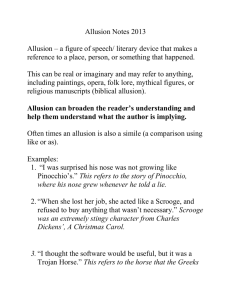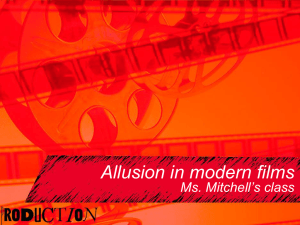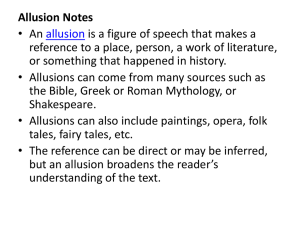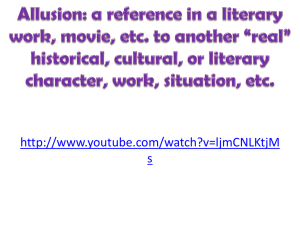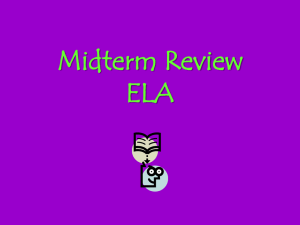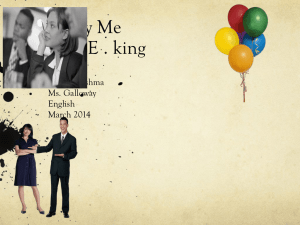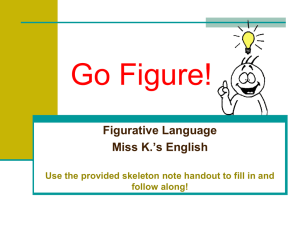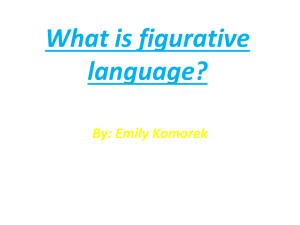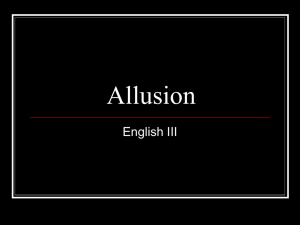Crash!
advertisement
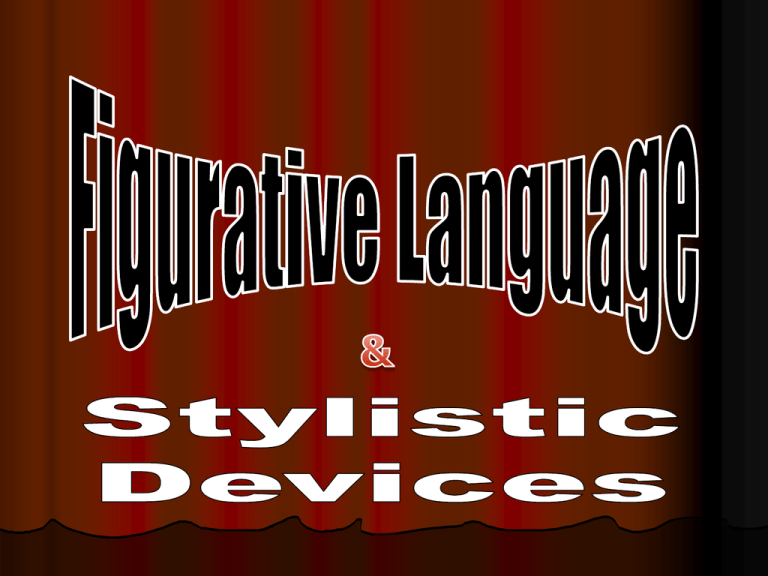
Figurative Language Figurative language refers to any language that helps to create mental images or language that makes different kinds of comparisons. Figurative language helps an audience (reader) better understand the story or text. What are some examples of figurative language? Stylistic Devices Stylistic Devices (sound devices)- are techniques used by a writer to add interest or meaning. Figurative Language Review: 1. 2. 3. 4. 5. 6. 7. Simile Metaphor Hyperbole Idiom Personification Onomatopoeia Imagery More Examples of Figurative Language/Stylistic Devices: 8. Oxymoron 9. Symbolism 10. Paradox 11. Alliteration 12. Onomatopoeia Simile A simile is a description that compares characteristics of two unlike things to one another, using the words like or as. Examples: The sea was as smooth as glass. That day, her smile was like the rainbow after the rain. Metaphor A metaphor compares characteristics of unlike things without using the words like or as. Examples: My face was a beet. I couldn’t believe I had fallen in front of the whole school. The clouds were fluffy cotton balls floating through the sky. Hyperbole A hyperbole is an extreme, obvious exaggeration Examples: Her hair was as tall as a skyscraper. It must have taken a gallon of hairspray to fix it. “Yes, I know. You’ve said that a thousand times already.” Idiom Idioms use words or phrases in a way that is different from its usual or “dictionary” meaning. An idiom is a phrase that should not be taken for its literal meaning. Examples: Would you please stop channel surfing? Can The eye. you lend me a hand with this ladder? little girl was the apple of her daddy’s Personification Personification- giving human qualities to inanimate objects Examples: The trees danced in the wind storm. The sun greeted the young girl as it peeked in her window. Onomatopoeia Onomatopoeia- when a word is used to suggest a sound that would normally be heard Examples: The bzzzzz of the bee was driving me crazy. Crash! As the two cars collided, pieces of twisted metal filled the street. Imagery • • Imagery- sensory details that help the reader hear, smell, see, taste, or feel what is being described Example: • When she screeched her fingers across the blackboard, our cat jumped into the air and chills ran up my spine. Allusion An allusion is a reference made to another story, song, play, movie, etc. that is not directly mentioned. The reader might not notice or understand an allusion in a piece of writing or a song if they are not familiar with the story, song, movie, etc. being referenced. Allusion- Examples You’re standing here all set to crucify- all set to find a scapegoat. What story is this allusion referencing? You would have thought she was the wicked step-mother had you seen the way she treated her little boy. What story is this allusion referencing? Allusion- Examples Yes, the phone, the phone is ring-ing… Can you please pick it up? I don’t have all day. What song does this allusion reference? Yes, he broke up with me. But, trust me, I’ll find my Romeo one day. It will just take me some time. What story does this allusion reference? Oxymoron An oxymoron is a figure of speech that combines two words that seemingly contradict each other. Oxymoron Examples My pants were a little big, but I wore them anyway. I know almost exactly how much it will cost me. I need an exact estimate of the cost. I can get lost in virtual reality for hours. I was all alone in a crowd of people. That was awfully nice of you to say. Symbolism A symbol is a person, place, action, object, or idea that stands for something beyond itself. Examples: The man kissed the cross on his chain before heading into the pit of snakes. The song I Hope You Dance by Lee Ann Womack is full of symbolism. The song isn't really about dancing at all ... dancing is a symbol for getting the most out of life. Irony Irony- the difference between what you expect to happen and what actually does happen Examples: The Titanic was promoted as being 100% unsinkable; but, in 1912 the ship sank on its maiden voyage. In Romeo and Juliet by William Shakespeare Romeo finds Juliet in a drugged state and he thinks she is dead. He kills himself. When Juliet wakes up she finds Romeo dead and kills herself. A man who is a traffic cop gets his license suspended for unpaid parking tickets. Sarcasm Sarcasm- a sharply ironical taunt; sneering or cutting remark: a review full of sarcasms. Examples: After walking into the classroom of misbehaving students, the teacher thanks them for their respect and excellent behavior while she was out of the room. You are not the brightest star in the sky now, are you? Yes, that’s a great example of exactly what not to do in the future. I’m not naming any names, but people like Timmy should really think before they speak. Cliché Cliché- an overused word or expression that is predictable Examples: It happened just in the nick of time. All is fair in love and war. I had the time of my life last night. He really annoyed me at first, but I guess it’s true, opposites attract. Chances are you won’t like everything about a person because every rose has its thorn. You need to remember that what goes around comes around. Paradox A paradox is a type of figurative language that contains ideas that seem to contradict or to go against logic. Example: People who exercise have more energy than people who don’t exercise. Alliteration Alliteration is the repetition of similar sounds at the beginning of words. This technique is popular with poets, but other writers may also use it for effect. Example: He was determined to doubt and dared me to debate it. Onomatopoeia Onomatopoeia is the use of a word that imitates a sound, such as buzz or hiss. Example The bang, boom, screech outside my window and the whirring of the chainsaw could mean only one thing; the men were still working to remove the fallen tree.
